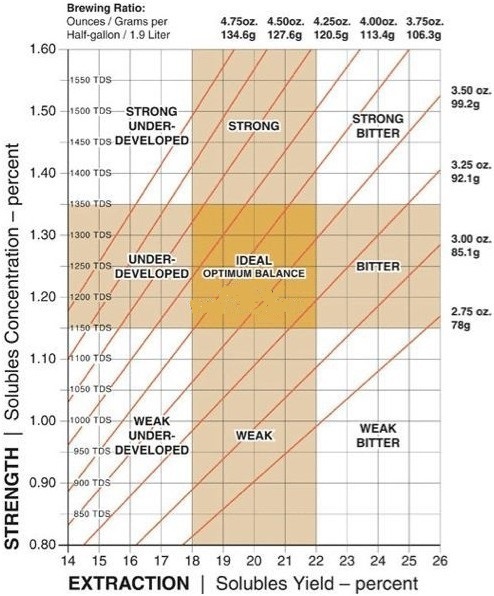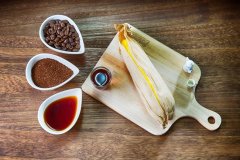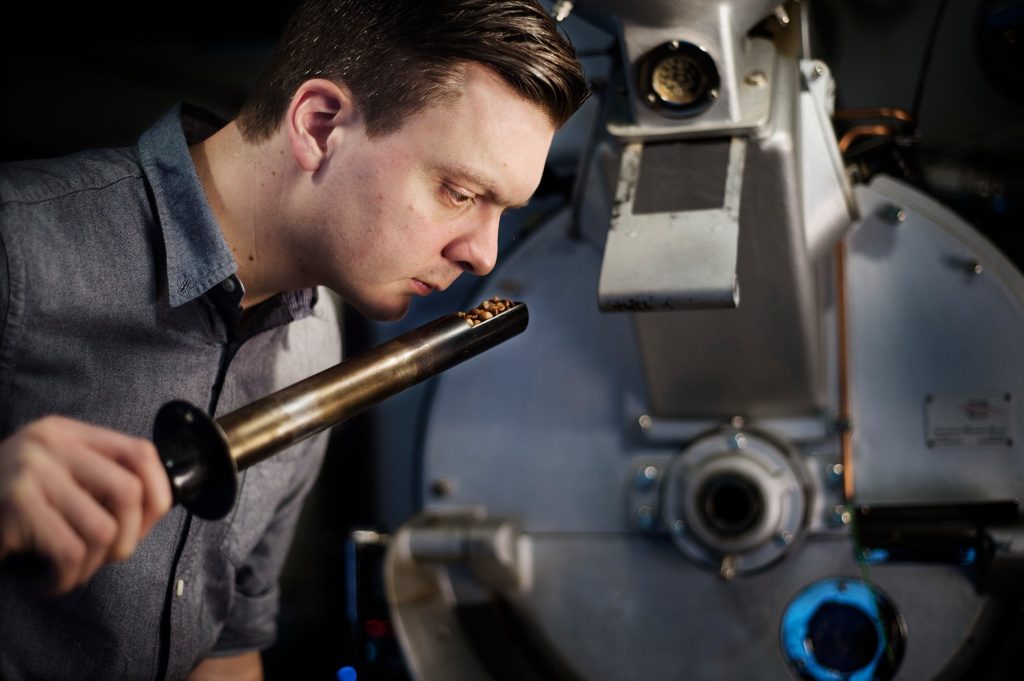SCAA American Fine Coffee Association standard cup measuring coffee grind, medium light dark roast coffee brew
From the comparison table, determine the predetermined coffee brewing amount and set the upper and lower limits of coffee powder amount, how to reach the optimal extraction rate from 0~30% to 18~22%, and the coffee brewing concentration is just 1.2%~1.45%, just like how to throw a good shot. This brewing a cup of Gold Cup coffee, after the above basic powder amount and brewing amount are determined, whether the optimal extraction rate of 18%~22% can be achieved, and the concentration falls within 1.2%~1.45%, involving the extraction rate problem, and coffee grinding thickness, water temperature, filter medium (affecting water retention time), etc.
There are five factors that control how to brew a good cup of coffee according to SCAE; no matter how you brew coffee, these five principles must be mastered.
Contact time: apply various brewing methods, to extract 18~22% extraction rate in its best extraction time, it is important to control the coffee grinding degree and water temperature.
Temperature of the water: 92°C~96°C to start brewing water temperature is necessary to master, too high or too low initial water temperature may be inappropriate.
Turbulence of coffee powder during brewing: disturbance is necessary for brewing to achieve the extraction rate, such as air stirring, hand flushing water column flushing intensity, etc.
Soaking coffee powder Wettability: Hand brewed,espresso, American There is a wetting stage before brewing. The amount of wetting water in this stage is 2ml of water per gram of coffee powder, and the soaking time is about 30sec. Of course, the roasting state of coffee beans has different pre-soaked wet states, and this part of hand flushing can be well controlled.
Uniform Dispersion: The brewing process allows water to evenly pass through each coffee powder, while the water temperature is consistent from the beginning to the end. Water extraction is important. For example, espresso emphasizes that the brewing water temperature and pressure are consistent.
SCAA American Fine Coffee Association Coffee Brewing Gold Water Powder Ratio
Coffee brewing method
French press
Percolator mocha pot
Drip Filter
Syphon plug siphon
Pressurised Infusion(Espresso)
As for the grinding thickness of coffee powder:
French press: Each coffee is ground into 100~300 coffee powders, about 0.7mm in diameter powder, which is about the size of the second special sugar particle.
Follicular drip filtration: Each coffee is ground into 500~800 coffee powders, about 0.5mm in diameter, that is, about the size of coffee with sugar particles.
Each coffee is ground into 1000~3000 coffee powders, about 0.35mm in diameter, that is, about the size of food refined salt particles.
Espresson: Each coffee is ground into 3500 coffee powders, about 0.05mm in diameter, which is about the size of flour particles.
SCAA standard cup test coffee powder grinding, 70~75% through the standard sieve #20(0.85mm) uniformity, about a little coarser than the French press.
SCAE also provides the concept of coffee brewing process and brewing time with different grinding thickness:
1. Wetting stage: At this time, hot water is added to the coffee powder to moisten the coffee and let the coffee extract dissolve. The amount of water is about twice the amount of coffee powder. The soaking time is about 30sce.
2. Brewing stage Water Cycle: At this time, depending on the size of the coffee powder, there is a different time for water to contact the coffee powder and dissolve the coffee extract.
a. French press: coarse powder, about 3~5min soaking
b. Dropping Follicle: The brewing process is about 1~3 minutes
c.Syphon: brewing process about 40~60sec
d.espresso: 30 second extract 30cc espresso
3. After extraction: At this time, coffee has extracted more than 50% of extractables, i.e. 60~70% of coffee soluble matter is extracted as the optimum extraction and the amount of water is adjusted to reach the optimum coffee concentration between 1.0~1.5%.
4. Coffee grounds after extraction: The water content in coffee grounds is about twice the amount of the original coffee powder (hand-washed follicular type).
Weight of some coffee pounds reference
1. Coffee beans: about 6 to 7 for 1g
2. Hario Syphon Measuring Spoon: 1 level spoon 8~9g
3. Hario V60 Measuring spoon: 1 level spoon 14~15g
4. Coffee beans (roasted):0.38~0.43 g/cm^3
5. Coffee powder:0.44~0.48 g/cm^3
6. A roasted 18/64″ coffee bean is a semi-ellipsoid with a major axis of 12mm, a minor axis of 8mm, and a height of 5 mm. It is said that coffee extraction is related to surface area. The surface area of the above coffee bean is 1.4 cm^2.
ExtractMOJO published by TDS and George Howell Coffee Company.
ExtractMojo is not a new concept. He simply continued SCAE's Gold Cup principle, making the theory and practice more convenient. For many people, this Gold Cup theory, which originated in the 1960s and was used to examine the quality of follicular coffee, is no stranger. But I must admit that this is the first time I have seriously tried to understand the principle and reformulate the theory of extraction.
Gold Cup coffee must maintain an extraction rate of 18 - 22% and a TDS strength of about 1.3%. This is a relationship between extraction rate and concentration that allows coffee to balance flavor interpretation. A coffee bean has about 30% soluble matter (the remaining 70% is insoluble structure, including xylem); while the standard extraction rate of Gold Cup is set at 20%; too low is under developed resulting in flavor imbalance, and too high is excessive extraction resulting in bitterness. Strength refers to the percentage of soluble substances in the coffee that have been washed out of the cup. The higher the percentage, the stronger the coffee will taste (strong), and vice versa (weak). With these two nouns in mind, the next step is to try to brew coffee to the goals of Extraction=20% and TDS=1.3%.
To achieve this goal of Extraction=20% and TDS=1.3%, Gold Cup has a recommended water to coffee ratio of approximately water: coffee= 17:1. ExtractMOJO convenient place is that you can fix the amount of powder (ground coffee), brewing water (brew water), or after the cup capacity (desired yield), three of the parameters, to calculate the remaining two should be how much. For example, if you want to brew a cup of coffee with a capacity of 240cc today, then after you fill in the number in this field, ExtractMOJO will suggest that you use 271.69ml of water with 15.19g of coffee powder (the software will estimate the average water absorption of coffee powder). First fix the water temperature (assuming 205F), measure the TDS value of the cup of coffee after brewing, and then input the software to obtain the falling point interval of brewed coffee, and correct it. If the TDS is too high, you can coarsen the powder or shorten the extraction time, and vice versa. Follow the data a few more times and you will soon be able to catch your Gold Cup brewing parameters.
If you want to make your coffee stronger or weaker, you can adjust the settings. After adjustment, the brewing parameters will also run. This is where ExtractMOJO comes in handy. You don't need to use a computer to calculate death, just throw the data in, follow the operation, and then correct it according to the actual TDS value. In principle, Extraction=18~ 22% and TDS=1.3~1.6% are acceptable ranges.
Through experiments, it was found that Clover's brewing, due to the deviation of the previous concept, used too much powder, and caused the coffee strength to be increased by increasing the TDS, but ignored the performance of the extraction rate, and made the coffee fall into the Strong/Underdeveloped; TDS= 1.7, Extraction =11%) range. This method of cooking, in addition to waste coffee powder, resulting in insufficient extraction rate, but let the production area flavor is not obvious problem. It is imperative to find new grinding, extraction times, and mesh sizes using the recommended amount of powder. If business productivity was taken into account, I couldn't brew coffee in the four minutes recommended by the Gold Cup, so I had to adjust the grind to shorten the brewing time. In addition, coarse filter (70 micorn) is more suitable for brewing Gold Cup than fine filter (100micorn).

With the help of the software, it took about one night to complete the extraction parameters, including brewing settings for medium, light and dark roast coffee. Of course, you can ignore this Gold Cup mode, but after I tested the Gold Cup coffee, I found a few significant differences compared to the coffee I brewed before:
1. The flavor of the producing area is more obvious
2. sweeter
3. Cleanliness becomes higher
4. drawl
Then, interestingly, I dropped the amount of powder from the ear-bag into the software and brewed it according to the recommended amount of water (200cc), but coincidentally got a combination of Extraction=20% and TDS=1.3% for the Gold Cup, which I did not expect.
Fifty years after the principle was invented, it is a very sorry thing for my coffee and customers to seriously explore the principle of gold cup and apply it in the store. I admit that in many cases taste should be the final deciding factor in the process. But sometimes, by neglecting the convenience offered to us by existing scientific principles, the process of exploration adds to the pain and uncertainty. This software, let me re-understand the operation principle of Gold Cup, but also because of the convenience of the software, let me adjust the existing process, to provide mojocoffee lovers closer to the perfect coffee.
Important Notice :
前街咖啡 FrontStreet Coffee has moved to new addredd:
FrontStreet Coffee Address: 315,Donghua East Road,GuangZhou
Tel:020 38364473
- Prev

SCA European boutique coffee association defines hand-brewed coffee, how to brew a good cup of coffee?
The proportion of SCAA fine cup coffee defined by the Gold Cup Fine Coffee Association of the United States and the scae European Fine Coffee Association must be about 20% of the coffee extraction rate, while the TDS is about 1.1% to 1.3%. For Drip Filter drip brewing, how to extract the best SCAA premium cup coffee ratio defined by the American Fine Coffee Association and the scae European Fine Coffee Association
- Next

Tim Wendelboe, the champion of Nordic Baking Competition: the characteristics and key points of Nordic Baking
Professional baristas please follow the coffee workshop (official Wechat account cafe_style) Tim made it clear at the beginning that the so-called Nordic shallow roasting is a term given by the rest of the world, he can only share his preference for coffee with everyone, not on behalf of all Nordic coffee. The relationship between water quality and coffee in Denmark because the TDS is too high, the water contains high calcium and carbon, which will make coffee drink.
Related
- Beginners will see the "Coffee pull flower" guide!
- What is the difference between ice blog purified milk and ordinary milk coffee?
- Why is the Philippines the largest producer of crops in Liberia?
- For coffee extraction, should the fine powder be retained?
- How does extracted espresso fill pressed powder? How much strength does it take to press the powder?
- How to make jasmine cold extract coffee? Is the jasmine + latte good?
- Will this little toy really make the coffee taste better? How does Lily Drip affect coffee extraction?
- Will the action of slapping the filter cup also affect coffee extraction?
- What's the difference between powder-to-water ratio and powder-to-liquid ratio?
- What is the Ethiopian local species? What does it have to do with Heirloom native species?

